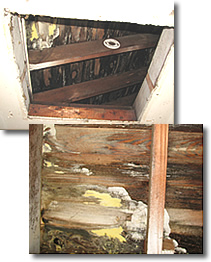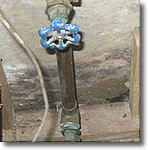|
I’m told that mold has been around since the beginning of time and I believe it. It has its place in our environment. Mold aids in the breakdown of cellulose and organic matter in nature. No one really notices or cares what mold does in nature. But when mold finds it’s way indoors and into our homes to the point where we notice it, now that’s a different story. 
In my work as a Certified Home Inspector, I often run into mold in viable and non-viable forms. Viable meaning alive and reproducing, non-viable meaning, dormant. There are several species of mold and they all seem to have varying levels of toxicity. Many of them are commonly found indoors, (i.e. Aspergillus/Penicillium), while others when found indoors triggers a significant concern, (i.e. Stachybotrys). Stachybotrys is known to have the highest toxicity levels of the molds studied by scientists.
 One thing you must understand about mold is that it is found in virtually every environment, indoors and out, this we cannot control. You must also understand that mold needs a food source to survive. Cellulose products such as paper, wood, and even paint are all food sources that can support mold growth. We build our homes essentially with mold food sources. The only thing that we as home dwellers can control is the last thing essential to support mold, and that is MOISTURE. Moisture is the key component in mold reproduction. If the environment in which we live has mold spores flying around, and we have spores constantly within our environment, there’s one only thing we can do to prevent a moldy scenario, and that is to keep the indoor environment dry enough so that mold does not have the last element it needs to reproduce. One thing you must understand about mold is that it is found in virtually every environment, indoors and out, this we cannot control. You must also understand that mold needs a food source to survive. Cellulose products such as paper, wood, and even paint are all food sources that can support mold growth. We build our homes essentially with mold food sources. The only thing that we as home dwellers can control is the last thing essential to support mold, and that is MOISTURE. Moisture is the key component in mold reproduction. If the environment in which we live has mold spores flying around, and we have spores constantly within our environment, there’s one only thing we can do to prevent a moldy scenario, and that is to keep the indoor environment dry enough so that mold does not have the last element it needs to reproduce.
Mold does not need water to thrive. It needs moisture. This moisture may come in other forms other than water such as high relative humidity. If the indoor humidity levels are over 55%, there is a high likelihood for mold to start forming on painted surfaces, paper products, fabrics, and/or wood framing. If there is marginal relative humidity and poor air circulation, mold can be found growing in this environment. All that is needed in a poorly ventilated space is an occasional leak, or seepage of water in such an area for mold to take shape.
What can you do to keep mold in check?
- Be sure to keep water where it belongs, in the pipes within the home. Any leaks should be address as soon as they are discovered.
- You should be monitoring plumbing and heating systems for leaks or the formation of condensation.
- Areas below ground ought to be well conditioned meaning, having an environment similar to the floor spaces above ground.
- Homeowners should be vigilant about the how water drains away from the home. Water should not be found directed toward the foundation.
- Be certain to have properly functioning gutters and downspouts with leaders discharging storm water sufficiently away from the foundation.
- Keep basements and crawl-space windows or vents closed during humid days.
- Maintain a properly sized operational dehumidifier in spaces below grade such as basements and crawl-spaces, particularly if you know the area is generally damp. Remember to drain it or obtain one that has a pump to prevent automatic shutting off of the unit.
The mold monster features in this issue can be a real monster to some of our readers. Don’t let this guy have a chance to grow in your home, but if by chance you find some evidence of mold in your home, you know who to call!
|

